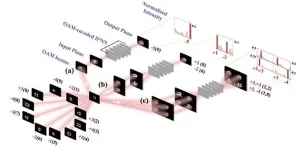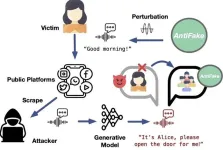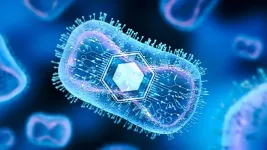(Press-News.org) Deep learning has revolutionized the way we perceive and utilize data. However, as datasets grow and computational demands increase, we need more efficient ways to handle, store, and process data. In this regard, optical computing is seen as the next frontier of computing technology. Rather than using electronic signals, optical computing relies on the properties of light waves, such as wavelength and polarization, to store and process data.
Diffractive deep neural networks (D2NN) utilize various properties of light waves to perform tasks like image and object recognition. Such networks consist of two-dimensional pixel arrays as diffractive layers. Each pixel serves as an adjustable parameter that affects the properties of light waves passing through it. This unique design enables the networks to perform computational tasks by manipulating information held in light waves. So far, D2NNs have leveraged properties of light waves such as intensity, phase, polarization, and wavelength.
Now, in a study published in the Gold Open Access journal Advanced Photonics Nexus, researchers from Minzu University of China, Peking University, and Shanxi University in China have developed three D2NNs with diffractive layers that can recognize objects using information held in orbital angular momentum (OAM) of light. These include single detector OAM-encoded D2NNs for single and multitask classification, and multidetector OAM-encoded D2NN for repeatable multitask classification.
But what is OAM? It is a property of light waves related to its rotation or twisting motion. It can take on an infinite number of independent values, each corresponding to a different mode of light. Due to its wide range of possible states or modes, OAM can carry spatial information such as an object’s position, arrangement, or structure. In the proposed D2NN framework, OAM beams containing information illuminating handwritten digits are combined into a single vortex beam. This beam, containing multiple OAM modes, each associated with a specific twisting or rotation of light waves, passes through five diffractive layers trained to recognize the characteristics of handwritten digits from the OAM modes.
A notable feature of the OAM-encoded D2NN is its ability to discern the sequence of repeating digits. To achieve this, the researchers employed multiple detectors to process OAM information of multiple images simultaneously.
When tested on the MNIST dataset, a commonly used dataset for handwritten digit recognition, the D2NN correctly predicted single digits in the images about 85.49% of the time, a level of accuracy comparable to D2NN models that leverage wavelength and polarization properties of light.
Utilizing OAM modes to encode information is a significant step towards advancing parallel processing capabilities and will benefit applications requiring real-time processing, such as image recognition or data-intensive tasks.
In effect, this work achieves a breakthrough in parallel classification by utilizing the OAM degree of freedom, surpassing other existing D2NN designs. Notably, OAM-encoded D2NNs provide a powerful framework to further improve the capability of all-optical parallel classification and OAM-based machine vision tasks and are expected to open promising research directions for D2NN.
For details, see the original article by Zhang, Liao, et al., “Advanced all-optical classification using orbital-angular-momentum-encoded diffractive networks,” Adv. Photon. Nexus 2(6) 066006 (2023), doi 10.1117/1.APN.2.6.066006.
END
Orbital-angular-momentum-encoded diffractive networks for object classification tasks
Encoding spatial information of objects into the orbital angular momentum of light enables the network to perform all-optical object classification
2023-11-27
ELSE PRESS RELEASES FROM THIS DATE:
Gig workers saw greater financial hardship during COVID-19 compared to other workers
2023-11-27
Many gig workers experienced financial hardships during the COVID-19 pandemic, including food insecurity and trouble paying bills, according to a recent study published in Work and Occupations.
“In a nutshell, our study shows gig workers were harmed more by the COVID-19 pandemic than any other workers,” said Dr. Mathieu Despard, a co-author on the paper and faculty member in UNC Greensboro’s Department of Social Work.
Despard – who collaborated closely with first author Daniel Auguste ...
CU Anschutz scientists create patch that may successfully treat congenital heart defects
2023-11-27
AURORA, Colo. (Nov. 27, 2023) – Using laboratory engineered tissue, scientists at the University of Colorado Anschutz Medical Campus have created a full thickness, biodegradable patch that holds the promise of correcting congenital heart defects in infants, limiting invasive surgeries and outlasting current patches.
The findings were published this week in the journal Materials Today.
“The ultimate goal is to make lab-grown heart tissue from a patient’s own cells that can be used to restructure the heart to correct for heart defects,” said the ...
Defending your voice against deepfakes
2023-11-27
Recent advances in generative artificial intelligence have spurred developments in realistic speech synthesis. While this technology has the potential to improve lives through personalized voice assistants and accessibility-enhancing communication tools, it also has led to the emergence of deepfakes, in which synthesized speech can be misused to deceive humans and machines for nefarious purposes.
In response to this evolving threat, Ning Zhang, an assistant professor of computer science and engineering at the McKelvey School of Engineering at Washington University ...
Revolutionizing cancer treatment through programmable bacteria
2023-11-27
What if a single one-dollar dose could cure cancer?
A multi-university team of researchers, supported by federal funding, is developing a highly efficient bacterial therapeutic to target cancer more precisely to make treatment safer through a single $1 dose.
Traditionally, cancer therapies have been limited in their efficacy in treating patients. Some, like radiation and chemotherapy, cause harmful side effects, while others tend to result in low patient responsiveness, not to mention the cost it takes to receive treatment. Findings from the American Cancer Society Cancer Action Network recorded ...
One protein is key to the spread of lung cancer. Now, a new study has found a way to stop it
2023-11-27
A new study by Tulane University has uncovered a previously unknown molecular pathway that could be instrumental to halting lung cancer in its tracks.
Lung cancer is one of the most common cancers and the leading cause of cancer-related deaths in the world. The research, published in the journal Proceedings of the National Academy of Sciences, could lead to the development of a new anti-cancer drug and more personalized lung cancer treatment, said senior study author Dr. Hua Lu, the Reynolds and Ryan Families Chair in Translational Cancer at the Tulane University School of Medicine.
The study found ...
Study: Spike in premature births caused by COVID, halted by vaccines
2023-11-27
MADISON, Wis. — COVID-19 caused an alarming surge in premature births, but vaccines were key to returning the early birth rate to pre-pandemic levels, according to a new analysis of California birth records.
“The effect of maternal COVID infection from the onset of the pandemic into 2023 is large, increasing the risk of preterm births over that time by 1.2 percentage points,” says Jenna Nobles, a University of Wisconsin–Madison sociology professor. “To move the needle on preterm birth that much is akin to a disastrous ...
Why does puberty trigger us to stop growing?
2023-11-27
All animals start out as a single-celled organism and then start growing. At some point, of course, they need to stop getting bigger, but the process by which this happens is poorly understood.
New research from Alexander Shingleton at the University of Illinois Chicago and colleagues identifies a potential trigger that makes fruit flies stop growing, which has implications for understanding human development. The research is published in the Proceedings of the National Academy of Sciences.
In humans, the body’s signal to stop growing happens around puberty, though it takes several more years before growth actually ceases. It is important to better ...
Maternal vaccination against COVID-19 lowered risk of preterm births, Stanford study finds
2023-11-27
During the first two years of the pandemic, a COVID-19 infection during pregnancy increased the risk of preterm birth and NICU hospitalizations. However, by 2022, when COVID-19 vaccines were readily available in the United States, this effect disappeared – suggesting that vaccination against the coronavirus may have prevented thousands of preterm births, according to a new study led by Stanford sociologist Florencia Torche.
The study’s findings, published Nov. 27 in the journal Proceedings of the National ...
UCF receives $1.5million NSF grant to improve energy efficiency of wireless communications
2023-11-27
Wireless devices consume more than just the hours users spend scrolling through social media, streaming podcasts and TV shows, and playing games. The networks used to connect these devices also consume a large amount of energy – up to a few thousand terawatt-hours annually worldwide, which is enough to power 70,000,000 homes for one year.
UCF researcher Kenle Chen aims to enhance the energy efficiency of these systems with the support of a $1.5 million grant from the National Science Foundation’s Addressing Systems Challenges through Engineering ...
No IKAROS, no antibodies
2023-11-27
A cell nucleus is a busy place. Cellular proteins twist and pull DNA, folding the genome into intricate 3D structures that support functioning of its coding parts.
This choreography is essential for cell development, and the exact steps vary wildly between cell types. Establishing proper communication between genes and far-away control switches at the right time in the right cell is not a small feat. In fact, very few proteins have the right combination of features to organize the genome into the right structures.
In ...
LAST 30 PRESS RELEASES:
SIMJ announces global collaborative book project in commemoration of its 75th anniversary
Air pollution exposure and birth weight
Obstructive sleep apnea risk and mental health conditions among older adults
How talking slows eye movements behind the wheel
The Ceramic Society of Japan’s Oxoate Ceramics Research Association launches new international book project
Heart-brain connection: international study reveals the role of the vagus nerve in keeping the heart young
Researchers identify Rb1 as a predictive biomarker for a new therapeutic strategy in some breast cancers
Survey reveals ethical gaps slowing AI adoption in pediatric surgery
Stimulant ADHD medications work differently than thought
AI overestimates how smart people are, according to HSE economists
HSE researchers create genome-wide map of quadruplexes
Scientists boost cell "powerhouses" to burn more calories
Automatic label checking: The missing step in making reliable medical AI
Low daily alcohol intake linked to 50% heightened mouth cancer risk in India
American Meteorological Society announces Rick Spinrad as 2026 President-Elect
Biomass-based carbon capture spotlighted in newly released global climate webinar recording
Illuminating invisible nano pollutants: advanced bioimaging tracks the full journey of emerging nanoscale contaminants in living systems
How does age affect recovery from spinal cord injury?
Novel AI tool offers prognosis for patients with head and neck cancer
Fathers’ microplastic exposure tied to their children’s metabolic problems
Research validates laboratory model for studying high-grade serous ovarian cancer
SIR 2026 delivers transformative breakthroughs in minimally invasive medicine to improve patient care
Stem Cell Reports most downloaded papers of 2025 highlight the breadth and impact of stem cell research
Oxford-led study estimates NHS spends around 3% of its primary and secondary care budget on the health impacts of heat and cold in England
A researcher’s long quest leads to a smart composite breakthrough
Urban wild bees act as “microbial sensors” of city health.
New study finds where you live affects recovery after a hip fracture
Forecasting the impact of fully automated vehicle adoption on US road traffic injuries
Alcohol-related hospitalizations from 2016 to 2022
Semaglutide and hospitalizations in patients with obesity and established cardiovascular disease
[Press-News.org] Orbital-angular-momentum-encoded diffractive networks for object classification tasksEncoding spatial information of objects into the orbital angular momentum of light enables the network to perform all-optical object classification



